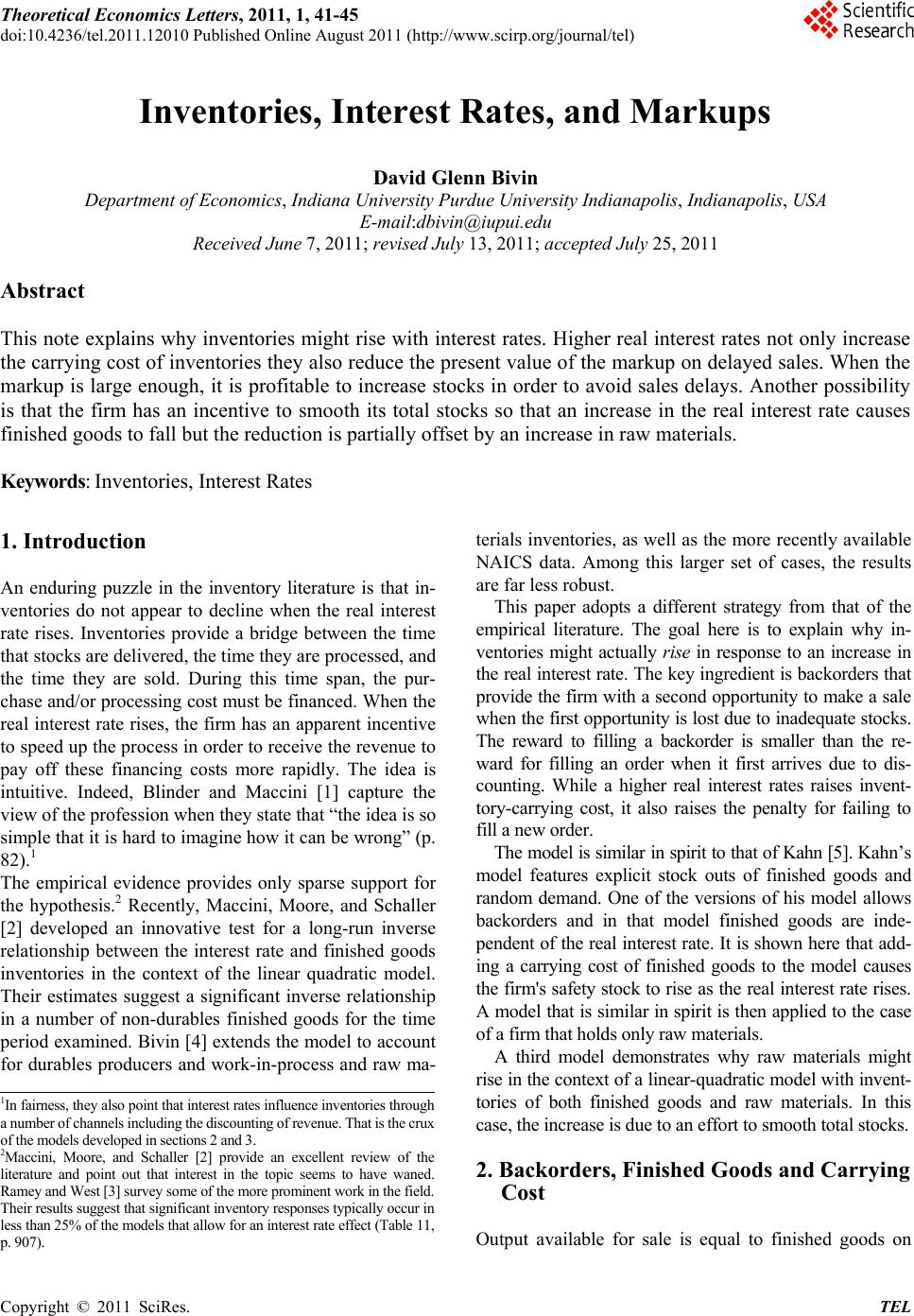
Theoretical Economics Letters, 2011, 1, 41-45
doi:10.4236/tel.2011.12010 Published Online August 2011 (http://www.scirp.org/journal/tel)
Copyright © 2011 SciRes. TEL
Inventories, Interest Rates, and Markups
David Glenn Bivin
Department of Economics, Indiana University Purdue University Indianapolis, Indianapolis, USA
E-mail:dbivin@iupui.edu
Received June 7, 2011; revised July 13, 2011; accepted July 25, 2011
Abstract
This note explains why inventories might rise with interest rates. Higher real interest rates not only increase
the carrying cost of inventories they also reduce the present value of the markup on delayed sales. When the
markup is large enough, it is profitable to increase stocks in order to avoid sales delays. Another possibility
is that the firm has an incentive to smooth its total stocks so that an increase in the real interest rate causes
finished goods to fall but the reduction is partially offset by an increase in raw materials.
Keywords: Inventories, Interest Rates
1. Introduction
An enduring puzzle in the inventory literature is that in-
ventories do not appear to decline when the real interest
rate rises. Inventories provide a bridge between the time
that stocks are delivered, the time they are processed, and
the time they are sold. During this time span, the pur-
chase and/or processing cost must be financed. When the
real interest rate rises, the firm has an apparent incentive
to speed up the process in order to receive the revenue to
pay off these financing costs more rapidly. The idea is
intuitive. Indeed, Blinder and Maccini [1] capture the
view of the profession when they state that “the idea is so
simple that it is hard to imagine how it can be wrong” (p.
82).1
The empirical evidence provides only sparse support for
the hypothesis.2 Recently, Maccini, Moore, and Schaller
[2] developed an innovative test for a long-run inverse
relationship between the interest rate and finished goods
inventories in the context of the linear quadratic model.
Their estimates suggest a significant inverse relationship
in a number of non-durables finished goods for the time
period examined. Bivin [4] extends the model to account
for durables producers and work-in-process and raw ma-
terials inventories, as well as the more recently available
NAICS data. Among this larger set of cases, the results
are far less robust.
This paper adopts a different strategy from that of the
empirical literature. The goal here is to explain why in-
ventories might actually rise in response to an increase in
the real interest rate. The key ingredient is backorders that
provide the firm with a second opportunity to make a sale
when the first opportunity is lost due to inadequate stocks.
The reward to filling a backorder is smaller than the re-
ward for filling an order when it first arrives due to dis-
counting. While a higher real interest rates raises invent-
tory-carrying cost, it also raises the penalty for failing to
fill a new order.
The model is similar in spirit to that of Kahn [5]. Kahn’s
model features explicit stock outs of finished goods and
random demand. One of the versions of his model allows
backorders and in that model finished goods are inde-
pendent of the real interest rate. It is shown here that add-
ing a carrying cost of finished goods to the model causes
the firm's safety stock to rise as the real interest rate rises.
A model that is similar in spirit is then applied to the case
of a firm that holds only raw materials.
A third model demonstrates why raw materials might
rise in the context of a linear-quadratic model with invent-
tories of both finished goods and raw materials. In this
case, the increase is due to an effort to smooth total stocks.
1In fairness, they also point that interest rates influence inventories throug
a number of channels including the discounting of revenue. That is the crux
of the models developed in sections 2 and 3.
2Maccini, Moore, and Schaller [2] provide an excellent review of the
literature and point out that interest in the topic seems to have waned.
Ramey and West [3] survey some of the more prominent work in the field.
Their results suggest that significant inventory responses typically occur in
less than 25% of the models that allow for an interest rate effect (Table 11,
. 907).
2. Backorders, Finished Goods and Carrying
Cost
Output available for sale is equal to finished goods on